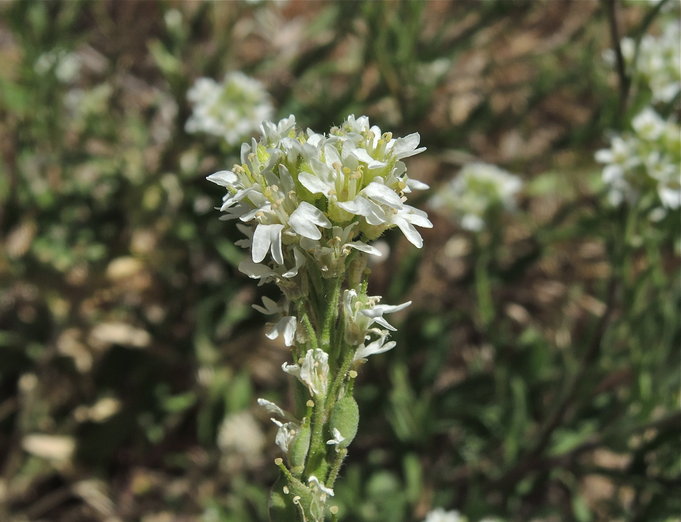Created by: Ramona Robison
Created on: Monday, Aug 15th, 2016
Created on: Monday, Aug 15th, 2016
Yes or No:
Yes
Points:
1
Confidence Level:
High
Answer / Justification:
Naturalized in California. Present in 4 counties according to Calflora. Also widely naturalized in northern North America.
Reference(s):
Yes or No:
Yes
Points:
2
Confidence Level:
High
Answer / Justification:
Naturalized in California. Present in 4 counties according to Calflora. Also widely naturalized in northern North America in some areas with similar climate.
Reference(s):
Yes or No:
Yes
Points:
2
Confidence Level:
Very High
Answer / Justification:
Noted as invasive in Great Lakes area and Canada, and it is also considered an invasive alien in parts of Europe (Germany, Switzerland and Slovakia) (Warwick and Francis 2006). It is also reported invasive in Colorado and Wyoming (USDA Forest Service). B. incana was listed as a Class B Noxious Weed in California in 2009.
Reference(s):
Yes or No:
Yes
Points:
3
Confidence Level:
Medium
Answer / Justification:
Noted as invasive in Great Lakes area and Canada, and it is also considered an invasive alien in parts of Europe (Germany, Switzerland and Slovakia) (Warwick and Francis 2006). There is some overlap in its invasive range with the California climate in Colorado, Wyoming and Europe.
Reference(s):
Yes or No:
Yes
Points:
1
Confidence Level:
Medium
Answer / Justification:
Berteroa is closely related to the Alyssum and Lobularia genera, both of which have invasive members in California and areas with similar climates. Examples include Lobularia maritima in California and Alyssum murale in Oregon.
Reference(s):
Yes or No:
No
Points:
0
Confidence Level:
Medium
Answer / Justification:
Most of the distribution points in GBIF do not match California's climate.
Reference(s):
Yes or No:
Yes
Points:
1
Confidence Level:
High
Answer / Justification:
Partly because of its adaptation to less fertile soils, hoary alyssum stands can become quite dense, requiring herbicide control measures, which are rarely used in hay and forage crops. Its ability to compete aggressively with native plants, through both persistence under dry conditions and continuous flowering and fruiting, can not only reduce an area’s productivity for use as grazing land, but can also have a detrimental impact on native ecosystems in park and conservation areas. On restored prairies in Minnesota its presence as an “alien weed” contributed to a reduction in species richness of pollinator communities, as it attracted a minimal number of pollinating insects (Warwick and Francis 2006).
Reference(s):
Yes or No:
No
Points:
0
Confidence Level:
Medium
Answer / Justification:
There is no information on whether this species promotes fire. However, since it is an annual and grows in dry upland soils it is not likely to promote fire.
Reference(s):
Yes or No:
Yes
Points:
1
Confidence Level:
High
Answer / Justification:
B. incana can cause toxicity to horses.
Reference(s):
Yes or No:
No
Points:
0
Confidence Level:
High
Answer / Justification:
B. incana is an annual or biennial plant up to 43 inches high without spines so would not impede movement.
Reference(s):
Yes or No:
No
Points:
0
Confidence Level:
High
Answer / Justification:
Although the species does form a tap root, its primary means of reproduction and spread is by seed.
Reference(s):
Yes or No:
No
Points:
0
Confidence Level:
Low
Answer / Justification:
Although the species does form a tap root, its primary means of reproduction and spread is by seed.
Reference(s):
Yes or No:
Yes
Points:
1
Confidence Level:
Very High
Answer / Justification:
Hoary alyssum is an annual, biennial or short-lived perennial.
Reference(s):
Yes or No:
Yes
Points:
1
Confidence Level:
Very High
Answer / Justification:
In a North Dakota study, the total number of seeds per plant averaged 2530, with a weight of 0.45 g per 1000 seeds. Another study found up to 300 fruits and 2640 seeds per plant (Warwick and Francis 2006).
Reference(s):
Yes or No:
Yes
Points:
1
Confidence Level:
High
Answer / Justification:
Hoary alyssum seeds germinate either in spring, and plants flower by fall, or they can germinate in fall, over-winter and then flower the following spring.
Reference(s):
Yes or No:
Yes
Points:
1
Confidence Level:
High
Answer / Justification:
Hoary alyssum seeds germinate either in spring, and plants flower by fall, or they can germinate in fall, over-winter and then flower the following spring.
Reference(s):
Yes or No:
Yes
Points:
1
Confidence Level:
Very High
Answer / Justification:
In B. incana, initiation of flowering requires a day-length of more than 14 hours, and plants most likely to complete a flowering and fruiting cycle would have flowered in late spring or early summer when days are long, and will continue producing flowers and fruits until frost. In some areas of California this could occur for 3 months or more.
Reference(s):
Yes or No:
No
Points:
0
Confidence Level:
Medium
Answer / Justification:
Seeds do not appear to travel far from the plants by natural means. There is no information on possible dispersal by such agents as wind, water, animals, or indirectly in manure or bird droppings.
Reference(s):
Yes or No:
No
Points:
0
Confidence Level:
Medium
Answer / Justification:
Seeds do not appear to travel far from the plants by natural means. There is no information on possible dispersal by such agents as wind, water, animals, or indirectly in manure or bird droppings.
Reference(s):
Yes or No:
Yes
Points:
1
Confidence Level:
High
Answer / Justification:
The most likely means of long-distance dispersal appears to be contamination of seed used for lawns and forage crops. Harvesting of weed-contaminated hay can also contribute to local spread.
Reference(s):
GBIF: http://www.gbif.org/species/3053522
USDA: http://plants.usda.gov/core/profile?symbol=BEIN2
GRIN: https://npgsweb.ars-grin.gov/gringlobal/taxonomydetail.aspx?id=7021
USDA Forest Service: http://na.fs.fed.us/fhp/invasive_plants/weeds/hoary-false-madwort.pdf
Jepson eFlora: http://ucjeps.berkeley.edu/eflora/eflora_display.php?tid=15612
- < 13 : accept (low risk of invasiveness)
- 13 - 15 : evaluate further
- > 15 : reject (high risk of invasiveness)
PRE Score:
17
Number of questions answered:
20
Screener Confidence (%):
76.0
Organization:
Evaluation visibility:
Public - accessible to all site users

